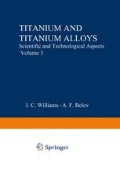Abstract
Modern technology demands of material more and often incompatible requirements, for example, the combination of very high strength along the high fracture toughness and lightness. cently there appeared many publications on titanium alloys possessing much higher mechanical properties as compared with those known before. There are many publications about the improvement of properties of known alloys by using new kinds of heat treatment. By the latter is meant mild quenching including cooling in the furnace from the ß-field to the temperature of α+ß field followed by cooling in air (1);two stage aging, namely at first aging at the temperature of existing ω-phase and then at temperature field of (α+ß) phases (2); different variants of thermomechanical treatment (3,4). Additional doping of known grades of alloys is widely used with the purpose of increasing strength and toughness. New composites are being developed using multicomponent alloying and such elements as Cu, Si, As.(5,6)
Access this chapter
Tax calculation will be finalised at checkout
Purchases are for personal use only
Preview
Unable to display preview. Download preview PDF.
References
Auvinet, J., Leleu, G., Notton, G. and Marquier, G., “Mem. Sci. Rev. met.,” 1973, 70, NII, 809–821, II, III, V.
Alheritiere, E., Morinier, R. and Syre, R., “4 eme Sornee etude aciers el alliag. Spee. sew. aviat. Bourget, 1971, ” Paris, 1972, k/I–k2. Duscuss k/23–k26.
Boyer, R., Taggart, R. and Polonis, O. H., Metallography 7, 241–251 (1974).
Nyffengger, W. and Schweisstechn., Z., 1972, 62, N 3, 61–76.
Seagle, S. R., Hall, G. S. and Bomberg, H. B., “Metals and Quart” 1975, 15, N I, 48–54.
Goosey Richard Ernest. Titanium-base alloys. (Imperial Metal Inds (Kynoch) Ltd.). Great Britain Pat. N 1298923. Cl.C7A. Int. cl. C22 015/00. Filed January, 7.71. Published December 6, 72.
Stubbington, C. A. and Bowen, A. W., The effect of section size on the fatigue properties of Ti-6A1-4V bars. “Titanium Sci. and Technol. Vol. 2”, New York-London, 1973, 1283–1296. Discuss. 1427–1428.
Collection. Applied questions of fracture toughness. Publisher “Mir, ”Moscow, 1968.
Author information
Authors and Affiliations
Editor information
Rights and permissions
Copyright information
© 1982 Springer Science+Business Media New York
About this chapter
Cite this chapter
Petrova, L.A., Grankova, L.P., Belyaev, V.I., Korshenevsky, A.P., Baikov, A.A. (1982). Model Composite (Layered) Material on the Basis of Titanium. In: Williams, J.C., Belov, A.F. (eds) Titanium and Titanium Alloys. Springer, Boston, MA. https://doi.org/10.1007/978-1-4757-1758-7_77
Download citation
DOI: https://doi.org/10.1007/978-1-4757-1758-7_77
Publisher Name: Springer, Boston, MA
Print ISBN: 978-1-4757-1760-0
Online ISBN: 978-1-4757-1758-7
eBook Packages: Springer Book Archive

